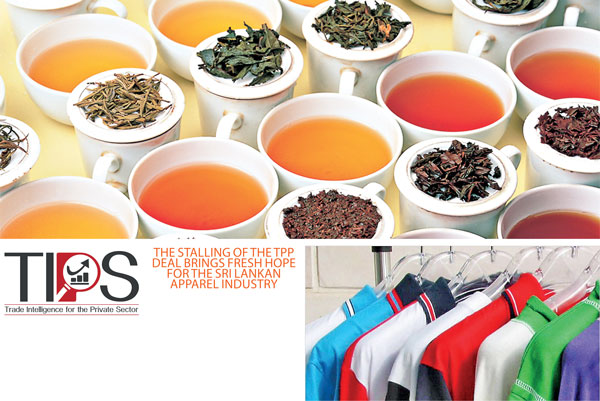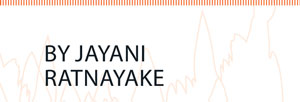08 Dec 2016 - {{hitsCtrl.values.hits}}

The latest available export results for August 2016 show that for the first time this year exports  recorded a year-on-year (YoY) growth, reversing an 18-month decline. According to export statistics released by the Central Bank, Sri Lanka’s cumulative export earnings during the first eight months of 2016 dropped by 4.1 percent on a YoY basis but August recorded a growth of 8 percent. This week’s TIPS column looks at the export performance of two key export products of Sri Lanka – tea and apparel – in 2016 and the industry experts’ views on the outlook for the near term.
recorded a year-on-year (YoY) growth, reversing an 18-month decline. According to export statistics released by the Central Bank, Sri Lanka’s cumulative export earnings during the first eight months of 2016 dropped by 4.1 percent on a YoY basis but August recorded a growth of 8 percent. This week’s TIPS column looks at the export performance of two key export products of Sri Lanka – tea and apparel – in 2016 and the industry experts’ views on the outlook for the near term.
Apparel sector – Export performance
Apparel exports contracted by 1.2 percent YoY during the first 10 months of 2016. The two major export markets – the European Union (EU) (42.3 percent) and United States of America (USA) (45.8 percent) – accounted for a share of 88.2 percent of total apparel exports of Sri Lanka in the period under review. The cumulative exports to the USA grew at 6.6 percent YoY retreating to a single-digit growth rate from the vibrant 14.7 percent and 14.5 percent growth rates recorded in 2014 and 2015, respectively.
Exports to the EU contracted substantially by 9.8 percent as uncertainty loomed over the EU market with the Brexit vote in the UK and elections in other European countries like Italy and Austria further aggravating an already weak market. Sri Lanka’s EU market share has witnessed a steady decline since the withdrawal of the EU GSP Plus from 50.1 percent in 2012 to 42.3 percent by 2016.
Apparel sector – Near-term outlook
Following the Sri Lankan prime minister’s visit to Brussels in late October 2016, it was announced that Sri Lanka’s application to regain GSP Plus is currently going through a technical assessment process. Industry leaders the author interviews remain hopeful about Sri Lanka’s ability to regain the GSP Plus concession. Meanwhile, in the USA, Congress has raised a red flag on the Trans-Pacific Partnership (TPP) agreement, stating that the USA will not go ahead with the deal, even before the President-elect Donald Trump takes office in January 2017.
Sri Lanka competes in the USA market for the same apparel products with the TPP partners like Vietnam, Mexico and Peru and if the deal was struck, Sri Lanka’s apparel exports would have been affected severely by losing out to Vietnam. The stalling of the TPP deal brings fresh hope for the Sri Lankan apparel industry. Yet, some industry experts commented that the stalling of the TPP deal will only give Sri Lanka temporary breathing space, as countries like Vietnam have already started making significant domestic reforms to improve their competiveness. Sri Lanka will need a proactive strategy to improve competiveness and expand market access to stay ahead of the game.
Tea - Export performance
The cumulative tea export earnings during the first nine months of 2016 recorded a 2.1 percent marginal growth from the same period last year but this was a significant 13.1 percent drop when compared to 2014 earnings. Weak export demand stemming from structurally low oil prices and macroeconomic instabilities in the Middle East and the Commonwealth of Independent States (CIS) including Russia (which accounts for about 63 percent of Sri Lanka’s tea market) are the main factors for this sluggish export performance.
Tea – Near-term outlook
In 2016, the tea industry faced significant headwinds from both the domestic and the global economy. The regional plantation companies (RPCs) are concerned about rigidities in domestic supply conditions. The serious shortfall in crops and the drop in production (-22 percent on a YoY basis during the first 10 months of 2016/2015) as a result of bad weather and the inability to fertilize due to the government ban on important weedicides (since April 2015) are critical challenges being faced by the industry.
Moving forward, these are leading to actual costs being much higher and could be around Rs.550 to Rs.600 per kilogramme. The industry leaders anticipate a slight improvement in the Middle East, Russia and other CIS countries during the first half (1H) of 2017. The Russian market has started showing some signs of recovery with the Russian rouble strengthening 20 percent against the US dollar, from the January 2016 low of USD/RUB 82.5 to 66 in late November.
The price of Brent oil has increased approximately by 53 percent during the same period. The industry is also anxiously watching the developments in the Organisation of the Petroleum Exporting Countries (OPEC) (with regard to a cut in production and a possible rise in prices), which will influence tea demand in Sri Lanka’s key export markets. Even if the global market conditions improve over 1H 2017, supply rigidities will make it challenging for the domestic tea industry to reap the full benefits.
(Jayani Ratnayake is an economist in the Economic Intelligence Unit of the Ceylon Chamber of Commerce (CCC). This article is part of the ‘Trade Intelligence for the Private Sector’ (TIPS) initiative of the CCC, aimed at enhancing awareness on trade policy issues among the
Sri Lankan private sector)
10 Jan 2025 25 minute ago
10 Jan 2025 45 minute ago
10 Jan 2025 2 hours ago
10 Jan 2025 2 hours ago
10 Jan 2025 3 hours ago